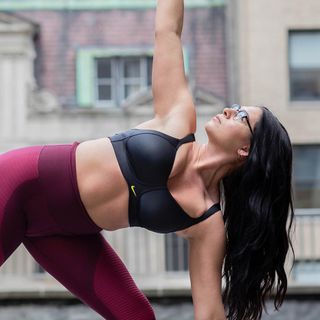This Is What Your Yoga Instructor Is Really Thinking

Isn't it ironic that—figuratively speaking—the best fitness instructors never seem to sweat? I always marvel at the fact that while it takes every ounce of my focus to make my way into Warrior III, my yoga instructor manages to demonstrate the pose, offer variations and insightful instruction, and make hands-on adjustments—all in a matter of seconds—before smoothly moving on. And she makes it all look like it's no thing.
But what's really going on in her head? How much training does it take to look that at ease in front of a class full of people? Moreover, what actually goes into planning a class on a given day? To fully understand what it's like to be a fitness instructor, it only made sense to get an insider's take—and as a yogi, group fitness instructor, and personal trainer, THE/THIRTY contributor Claire Fountain certainly has ample perspective.
Keep reading to see what really goes into teaching a fitness class.

1. It's not all fun and games—it's a job.
Many of us find respite in our post-work fitness classes, but instructors work tirelessly behind the scenes to make that happen. "As fun as it might seem, it is a job," says Fountain. "It is work." When it's your full-time gig, there are financial aspects to consider, as well as extensive training. That's not even to mention all the planning that goes into every single class and training session.
2. There are a lot of factors that go into planning a class.
Timing, transitions, and class level all come into play for Fountain's yoga classes. "It also depends on what you're working on in a given class or series of classes—a four- to five-class series on backbends, for example," she says.
That being said, consistency is a large part of Fountain's classes (though every instructor ultimately has their own preferred approach). "I have a structure I really like that's close to the Ashtanga series," she says. "So it can become repetitive because I think the repetition is a necessary and soothing part of the practice."
With time and experience, a lot of the planning—and in turn, teaching—becomes second nature. "When I first started, I would write my flows out and go over them before my class to watch for time and proper transitions," says Fountain. "Now I'm versed enough to know what I'm doing, practice it in my head with a few notes, and make adjustments during class if need be."
3. Multitasking is basically a job requirement.
"I am constantly checking on people's bodies and alignment and trying to keep an eye on everyone, all the while talking and cueing," says Fountain. That's tough when classes are packed. "Training is more of a one-on-one thing, so it's much easier to correct form," she says. "It's one of the reasons I have never preferred group training or yoga classes, because I care a great deal about people learning and being safe. It's hard when it's 50 to 100 people, even if the energy is amazing in large groups."
4. Your instructor is not necessarily the perfect picture of health.
Believe it or not, they're actually human. According to Fountain, people think "that we don't get tired or sore, or that we work out every day, that we are the 'healthiest people ever' and shame people who, say, eat a burger around us. I'm laid-back, not vegan, and probably have as many gin and tonics as I do workouts a week. And as for the tired and sore part? Absolutely. Massages are our best friends as our work is physical on top of our own fitness regimens (if we can even maintain them!)."
5. They want to chat with you (just maybe not during class).
"Speak up if you're new, have an injury, or don't want to be touched (for adjustments in yoga)," says Fountain. "It's all okay; we just need to know. Ask questions after class if something didn't make sense or you're not sure you are doing it correctly."
6. Speaking of proper class etiquette…
"Most of all, be kind and respectful to the other students, the instructor(s), and the studio or gym you're attending," says Fountain. "That includes the front-desk employees and maintenance staff, too. Don't jump on the yoga mats in sneakers or walk on people's towels. Don't hog spaces or give attitude to those who might be new and/or confused in class. Little things like not talking during yoga and staying for final relaxation matter as well." Basically, it's about practicing common courtesy.
7. The most rewarding parts of teaching often happen outside of class.
Fountain loves "when people, especially fellow women, come up and share their stories. It will forever touch my heart that I can inspire someone or make them feel better about themselves."
Next up, take a look at a day in the life of a vegan ballerina.
Disclaimer
This article is provided for informational purposes only and is not intended to be used in the place of advice of your physician or other medical professionals. You should always consult with your doctor or healthcare provider first with any health-related questions.

